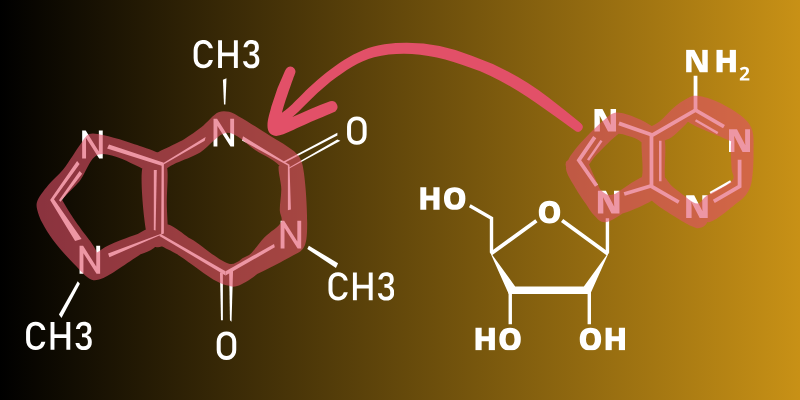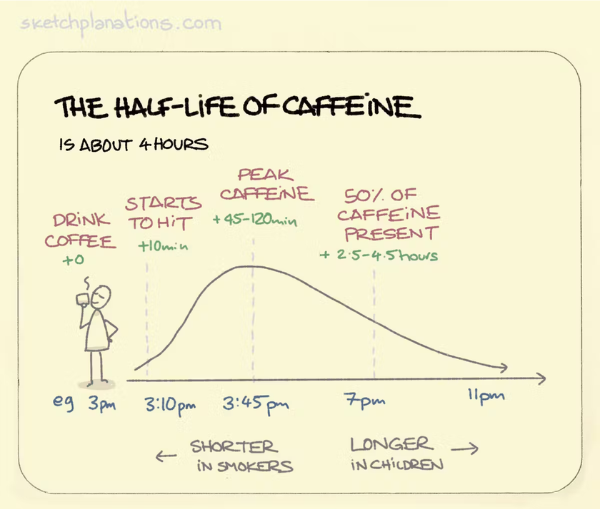The Chemical Process of Caffeine
The chemical process of caffeine is what many people rely on every day, yet hardly anyone knows how their morning pick me up, picks them up.
Caffeine, the world’s most widely consumed psychoactive substance, is a central player in our daily routines.
From the morning cup of coffee to the afternoon tea, caffeine finds its way into the lives of millions.
But have you ever wondered what happens to caffeine once it enters your body?
Let’s embark on a journey through the chemical processes of caffeine, and how it navigates through the intricate pathways of the human body.
The Beginning of the Chemical Process
The process begins as you take that first sip of your favourite caffeinated beverage.
Caffeine then swiftly makes its way into the bloodstream through the walls of the stomach and small intestine.
The caffeine is absorbed within 15-45 minutes and it is now on a mission to bind with adenosine receptors in the brain.
Adenosine, a neurotransmitter, plays a key role in promoting sleep and relaxation. Caffeine, being the sneaky impostor it is, mimics adenosine’s structure, tricking the receptors into accepting it.
This prevents adenosine from doing its usual job and leaves you feeling more alert and awake.

Caffeine’s Interaction with Neurotransmitters
Now firmly embedded in the adenosine receptors, caffeine sets off a chain reaction involving other neurotransmitters like dopamine and norepinephrine.
These “feel-good” chemicals lead to an increase in neuron firing, promoting improved mood, enhanced cognitive function, and heightened alertness.
Moreover, caffeine acts as an inhibitor of phosphodiesterase, an enzyme that typically breaks down cyclic AMP (cAMP).
By inhibiting this enzyme, caffeine indirectly increases cAMP levels, further amplifying the stimulatory effects in nerve cells.
Caffeine’s Process Coming to an End
Ever wondered why the kick from that cup of coffee doesn’t last forever?
Caffeine has a half-life – the time it takes for the body to eliminate half of the ingested caffeine.
For most individuals, the half-life ranges from 3 to 5 hours.
This is a factor which depends on the rate of an individual’s metabolism, which is determined by age. It can also be determined by liver function.
This means the given time, only half of the caffeine you consumed remains in your system.



Enzymes in the liver, particularly cytochrome P450 1A2, play a crucial role in breaking down caffeine.
Genetic variations can impact the efficiency of these enzymes, contributing to individual differences in caffeine metabolism.
Coming to the End of Caffeine’s Chemical Process
As the hours pass and caffeine’s effects start to wane, the body undergoes a subtle but noticeable shift.
Adenosine, suppressed during the caffeine-induced alertness, begins to rebound.
The adenosine receptors, now free from caffeine’s interference, become more open, and receptive.
This is what many people commonly refer to as the “caffeine crash”.
As adenosine takes back control, you may experience a sense of fatigue or drowsiness. It’s the body’s way of signalling that it’s time to rest and recharge.
Caffeine’s Exit Strategy
To complete the journey, caffeine must be broken down.
The liver then works diligently to break down caffeine into metabolites.
The primary metabolites include paraxanthine, theobromine, and theophylline.
Each of these has its own set of effects, contributing to caffeine’s overall impact on the body.
Most of these metabolites are water-soluble and are excreted through urine.
This is why staying hydrated plays a crucial role in expediting the elimination of caffeine from your system.
To Conclude
Understanding the process of the chemical dance between caffeine and your body provides valuable insights into the mechanics of wakefulness, alertness, and the inevitable crash.
While caffeine can be a helpful ally in our daily lives, moderation is key.
Knowing the intricate journey caffeine takes through your body can influence you to make informed choices about when, and how much to indulge in your favourite caffeinated delights.
So, whether you’re savouring that morning cup of coffee or enjoying an afternoon tea, remember that the chemical process of caffeine is orchestrating a fascinating symphony within you.
Read more about the withdrawal of caffeine here.
Read about the motivations of the author here.